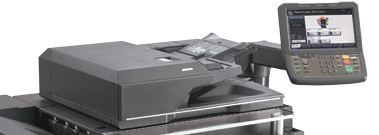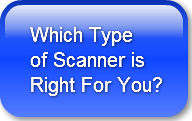It is common for many offices to use a multifunction printer (mfp) product for scanning. When you are considering the purchase of your next unit, here are 7 factors to consider before you decide.

-
Paper Size - If your scanning is limited to letter sized documents then the choice of mfp device will be expanded, however if you need ledger capability (11 x 17) then you will be limited to considering the more traditional copier format of device. Most mfp devices will scan legal size paper without an issue, but smaller units may only do so through the document feeder.
-
Mixed originals - Some mfp feeders do not easily manage the sorting of mixed original sizes when you are scanning. If this is a significant part of the volume of documents you will scan then you should be sure that the device you select can adjust automatically to deal with mixed originals. Anything else will lead to a massive decrease in productivity.
-
Volume of scanning - This is a question that I ask every client that is looking for scanning on their device. The answers are generally, 'we'll do lots of scanning.' This is not precise enough, Just today one of our reps had a client tell him they would do lots of scanning. When pursued the amount was ten pages per day. This is a miniscule level of scanning for most mfp devices today. Understand your volumes and match the capability of the device to them.
-
Length and types of documents - Scanning many one or two page documents is very different than scanning large documents with fifty or more pages in each. There are many features like jam recovery and size of document feeder (some can hold up to 260 sheets) that can have a big impact on scanning long documents and resulting productivity.
-
Output requirements - Most mfp devices can output scans in either Tiff or PDF format. Choices for scan resolutions are built into devices. Unfamiliar users often focus on the maximum resolution but other than for colour high resolution scans most users will actually use resolutions like 200 or 300 dpi in black and white due to the size of files created by higher resolution. Scanning to e-mail in either format is also an important consideration in some installs.
-
Type of document feeder - There are two main types of document feeders that are found on mfp units. The first is an automatic reversing document feeder, ARDF, which pulls the paper in, scans one side, pushes it out and flips it and then pulls it back through for the other side. These work fine for low to medium volumes of letter paper in good condition. If your paper is not of this quality or you are going to do a lot of scanning then look for option two. In this option the document feeder does what is known as single pass dual scan. These are much more robust feeders which will scan both sides of a page in one pass. They are more reliable than ARDF type feeders but do add cost to the device. If you are doing any volume of ledger paper then avoid an ARDF.
-
Size and cost of device - Don't expect to do a large volume (in excess of 50 pages per day) of scanning on a device which you buy in the box store. The document feeders on this level of device will not hold up over time with steady and continuous scanning. The higher your scan volume the more robust the device you need to consider. Dcoument feeders are highly taxed devices when run at volume and require maintenance and support.
MFP printers can be a valuable tool for feeding your scanning operations. Picking the right one for your environment and matching the capabilities of the device to your needs can lead to many months or years of satifaction. On the other hand, acquiring a device that is a miss match to your needs can lead to daily aggravation for your users for many years. Your investment can be wasted with the wrong choice.
Get advice from a supplier that takes the time to understand your environment, who asks the questions needed to configure the right solution for you and who will stand behind the choice with proper service. You can having a winning mfp scanning solution for your office.
Do you understand your scanning needs? What drives your MFP choice? Is scanning one of the factors?
Lee K



